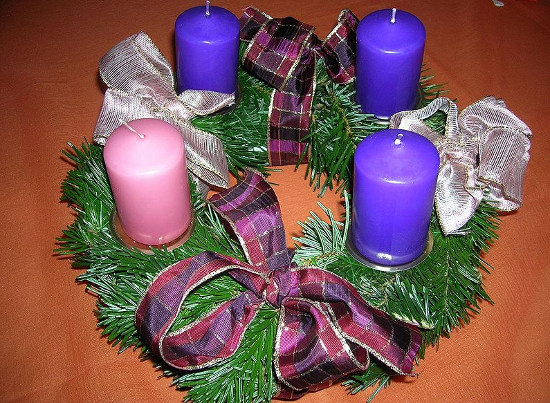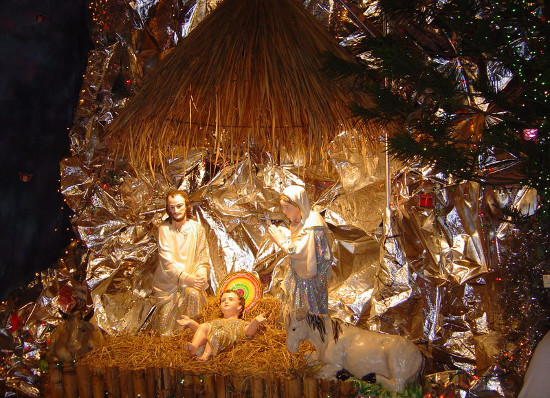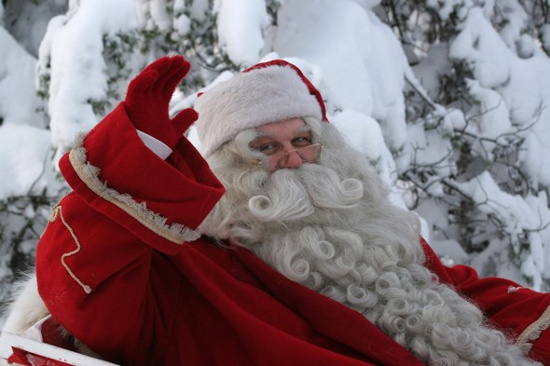Why is there a Christmas? (2)
Ice cave, manger, star, Christmas tree . are indispensable symbols every Christmas.
>>>Why is there a Christmas? (first)
Advent ring

Seasonal leaf ring Hope is a circle made of green leaves that are usually placed on a table or hung high for people to see in the 4 weeks of Advent. On leaves placed within 4 candles.
The circle of the circle has the eternal character and the endless love of God. Green says hope that the Savior will come to save man. Four candles include three purple trees, the color of Advent season, the fourth tree is pink, the color of the third Sunday of Advent; or 4 red candles, one candle is burned every week.
Stone cave and manger

In the Christmas season, a manger is placed in a stone cave (or wood) set up indoors or outdoors, with images of Jesus, Mary, and Joseph, surrounded by angels, and shepherds cattle like cows and donkeys to recount the story of the Lord's birth in a manger.
Santa Claus

Santa is a symbol of kindness, always bringing good luck and peace to everyone. He used to ride a reindeer car in the sky, go to a Christmas tree with a Christmas tree and climb over the chimney to bring gifts to the sleeping children and often put presents in socks.
Christmas tree

On Christmas occasion, people often shop a pine tree and decorate stars, berries, sparkling tinsel strips, flowers up . Pine trees are seen as symbols of hope and vitality. New in the festival to welcome the new year.
Christmas candles

The light of the candles means to light up hope, peace, love and joy.
Christmas star

The star is a symbol of meaning in the Christmas season and is always hung in the most solemn place in the cathedral, on Christmas trees . The image of the star is the symbol of God about the promise from the past. God promises to send a savior to the world, and the star is a commitment to His promise. People in Christianity believe that the starlight is the power of the Lord's power, dispelling the darkness of the cold winter night, lighting up a new warm and happy spring for all people.
Christmas gift

Christmas gifts are gifts that show the love of people to family and friends. When Jesus cried out in Bethlehem in a manger, three wise men from the East came to show their respect. They brought three precious gifts, gold, frankincense and wood. Gold means to say that Jesus is king, frankincense to proclaim Jesus is God and the medicine proclaims the tribulation and death of Jesus to redeem mankind.
Poor people with almost no wealth also bring anything that can be revered to the Child. Shepherds give fruit Jesus and small toys created by themselves.
Children hope to receive the most gifts. On Christmas holidays there is a custom of children hanging socks by the fireplace to receive their dream gifts from Santa. Everyone in the house also took this opportunity to give gifts to the children with the expectation that they will be obedient and study well.
Buche Noel Cake

The ancestors of Western people often group firewood in the home chimney, they believe that the more the fire rattles, the evil spirits will stay away. Today, customs are losing because there are not many houses with chimneys. Instead, according to the initiative of a French baker, in 1875, people made a sweet cake with firewood pictures for everyone to enjoy in Christmas Eve and handed down until now.
Christmas market

Christmas Market is a traditional street market held around Christmas (usually starting about a month before Christmas) originating in what is now Germany and Northeastern France. Beginning to appear from the late Middle Ages (around the 14th century), until now the Christmas market is still a unique traditional culture of Germany, Austria and East North France during Christmas, as well as being popular. to many other countries in the world.
- Sustainable agriculture model for alkaline soils
- Super NASA computers simulate a whirlwind from a drone plane
- Symbian encourages cheap 3G services
- This invention can eliminate complications in cosmetic and medical surgery
- Arsenic can be fatal after 20 years
- Students make instant hemostatic substances
- Normal indicators when evaluating a semen test
- Free gifts from NASA
- Beams of lemurs 'ballet, hip hop dance'
- Tomorrow, the North is very cold, with hail
- Shouting sharks 'hunting' plastic waste
- Crows hold secrets about aliens?
 'Fine laughs' - Scary and painful torture in ancient times
'Fine laughs' - Scary and painful torture in ancient times The sequence of numbers 142857 of the Egyptian pyramids is known as the strangest number in the world - Why?
The sequence of numbers 142857 of the Egyptian pyramids is known as the strangest number in the world - Why? History of the iron
History of the iron What is alum?
What is alum?